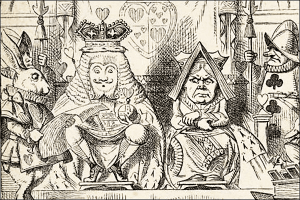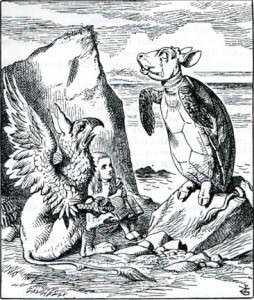Imbue Your Online Videos with Adventure and Story
There is a scene in Lewis Carroll’s Alice’s Adventures in Wonderland when Alice, the cheery protagonist, is chatting with the mopey Mock Turtle and the oft exasperated Gryphon about her goings on in Wonderland. The three have the following exchange:
“I could tell you my adventures—beginning from this morning,” said Alice a little timidly: “but it’s no use going back to yesterday, because I was a different person then.”
“Explain all that,” said the Mock Turtle.
“No, no! The adventures first,” said the Gryphon in an impatient tone: “explanations take such a dreadful time.”
Lewis Carroll was probably not thinking about marketing or branding or anything adult and dreary when he was writing the Gryphon’s exclamation. But those words – “No, No! The adventures first…explanations take such a dreadful time” – should be foremost in any video marketer’s mind when they set about crafting an online video.
Rather than become mired in the swamps of exposition or, worse yet, the fens of indulgent crowing, video marketers need to recount adventures; storytelling and online video marketing should be thought of as indivisible and inseparable. Online viewers, who are no less impatient than Carroll’s Gryphon, will not suffer “explanations.” They have little time and many cat videos to watch, after all.
“The Storytelling Animal:” The Neuroscience Behind Storytelling

Our species has been honing its storytelling chops since we first began to speak with one another. Stories allowed people without written language to tell one another about their universe and make sense of it. This is how stories function among contemporary Australian Aborigines and other pre-modern cultures. Stories could also convey moral messages that fostered good behavior; the fairy tales collected by the amateur folklorists, cultural researchers and authors, such as the Brothers Grimm, are filled with undisguised admonitions and warnings.
It’s not easy to unpack the myriad reasons why humans like stories. For our purposes, acknowledging our universal fondness for them is enough. In his “The Storytelling Animal,” educator and science writer Jonathan Gottschall eloquently writes about the ways that stories affect their listeners: “Human minds yield helplessly to the suction of story. No matter how hard we concentrate, no matter how deep we dig in our heels, we just can’t resist the gravity of alternate worlds.” Few of us would disagree, even if the mechanics of why the human mind so readily surrenders to story are still understood but imperfectly.
How to Tell a Story in Online Video
Even if you appreciate that narratives should be integral to your video marketing – it’s hard to know how to best do the integrating. Happily, however, there are two ways of designing an online video so that it communicates a compelling story: the Three-Act Structure and the Five-Act Dramatic Structure.
 To qualify as a Three-Act Structure, a story must contain three components: a setup, a confrontation and a resolution. In the first of these components, you need to explain a problem or introduce a challenge to your viewer. You must either dramatize a legitimate problem faced by consumers or create the kind of straw man familiar to anyone who has written a paper for an undergraduate philosophy class. In the second component – the confrontation – you must make tangible the effects problem or challenge you previously introduced. Finally, in the resolution to your story, you must introduce a solution to the problem. Presumably, this solution will be available for purchase on your website.
To qualify as a Three-Act Structure, a story must contain three components: a setup, a confrontation and a resolution. In the first of these components, you need to explain a problem or introduce a challenge to your viewer. You must either dramatize a legitimate problem faced by consumers or create the kind of straw man familiar to anyone who has written a paper for an undergraduate philosophy class. In the second component – the confrontation – you must make tangible the effects problem or challenge you previously introduced. Finally, in the resolution to your story, you must introduce a solution to the problem. Presumably, this solution will be available for purchase on your website.
For those looking to contrive a more nuanced and thoughtful video for your video marketing, there is the Five-Act Dramatic Structure, an edifice with quite the historical pedigree; this was the structure used by Elizabethan playwrights, like William Shakespeare and Christopher Marlowe.
This structure is built from the following five components: the Exposition, the Rising Action, the Climax, the Falling Action, and the Dénoument.
- The Exposition introduces main characters and conflicts, in much the same way that the “Setup” does.
- The Rising Action continues and, crucially, intensifies the conflicts introduced in the Exposition.
- The Climax of your tale is not the part of the story where the conflicts introduced and escalated in the earlier components are resolved. The Climax is where you offer your characters a way to confront these conflicts. To take an example from a film with which we are all likely familiar: this is where we learn, in “Star Wars IV: A New Hope,” that the Death Star, far from being indestructible, can be destroyed if it is struck at one particular point. (Hopefully, the solution you offer your characters will not require viewers to suspend every ounce of their disbelief.)
- The Falling Action is where, to continue our previous example, you explode the Death Star. This is where you apply the solution discovered and described in the climax of the story.
- The Dénoument is comparable to the Resolution described above. This is where the challenge introduced in the beginning is subdued, allowing your principal characters to go on with their happy lives. (This is video marketing and not Shakespeare; it’s likely that most of your characters have not been slain in dramatic and excruciating ways.)
These descriptions are little more than sketches; they are “more what you’d call ‘guidelines’ than actual rules.” But they should suggest how important timing and sequence are to good storytelling. This is something every bard has long been aware of, as the video below demonstrates:
What Makes A Good Story?
We’ve looked at how narratives can be crafted in such a way that your audience will, in Jonathan Gottschall’s memorable words, “yield helplessly to the suction of story.” But no number of cunning structural strategies will lend that special mesmeric quality to an inherently uninteresting story. That’s why, in online video, story selection is just as important an art as story presentation.
Good stories are often about a trial that must be confronted and overcome or about an obstacle that must be surmounted, or they simply surprise the audience in some way.
Adam Gopnik emphasized the latter characteristic in a piece from the New Yorker, in which he compared great scientific discoveries to great stories. Gopnik wrote the following:
Good stories are strange. What strong scientific theories, even those crafted in pop form, have in common with good stories is not some specious universality. It’s that they make claims so astonishing that they seem instantly very different from all the other stories we’ve ever heard…The narrative excitement of the great scientific theories, far from residing in their reassuring simplicity, lies in their similarly radical exclusions, their shocks: Everything in the whole universe is instantly attracting everything else! Everything! The big earth is dully pulling the apple and the apple is pluckily pulling on the earth.
What Gopnik is alerting us to is the fact that the best stories tell us something new; they are not recapitulations of yarns we’ve heard many times before but, rather, they mesmerize with their novelty. You may not be able to create a video marketing piece that equals the story communicated by Newton’s law of universal gravitation, but you should aim to do the same thing it does: upend, startle and surprise.
We’ve covered a lot of ground in this post, so perhaps its best to end on a quick exhortation. Video marketers would do well to remember the following sage advice from the blissfully simple yet sage King in Alice’s Adventures in Wonderland:
“Begin at the beginning and go on till you come to the end: then stop.”
The End

 972-318-2811
972-318-2811 info@globalvideohq.com
info@globalvideohq.com
